No-one is the other like, and everyone is unique, are things we hear and have been fed with since being children.
But in marketing, those ideas often seem to have gone lost.
Because most brands market to the large crowd, without thinking about the individuals in that crowd.
But after all, it is to the individuals we sell, not to the large crowd, and marketers need to understand that. Luckily, a lot of them do, plus, you’re here, so that means you’re ready to take the next step.
Every customer has different needs, different perspectives, and ideas. And the way you market to the individuals in a more personal and tailored manner is by leveraging segmentation in your marketing.
In this article, we’re looking at how you can leverage segmentation in your marketing, so you can craft better and more relevant marketing campaigns to each and every one of your prospects, so ultimately, they convert.
What is market segmentation?
Wikipedia explains market segmentation like this:
”Market segmentation is the process of dividing a broad consumer or business market, normally consisting of existing and potential customers, into sub-groups of consumers (known as segments) based on some type of shared characteristics. Researchers typically look for common characteristics such as shared needs, common interests, similar lifestyles or even similar demographic profiles. The overall aim of segmentation is to identify high yield that is, those segments that are likely to be the most profitable or that have growth potential – so that these can be selected for special attention (i.e. become target markets).”
Essentially, market segmentation has two ”benefits”, or more correctly, two main ideas behind it.
The first is a similar tactic that you use when developing your marketing strategy. This of course also includes defining your target audience. Now, the difference with market segmentation is that you then divide those individuals into sub-categories, known as segments, but the core idea of it remains – to identify your target audience.
Secondly, and this is the main reason for market segmentation, is that you identify similar traits and characteristics in your customers. This is a bit similar to developing customer personas, the only difference is that segments are more like categories that resemble a particular group of customers rather than individual personas.
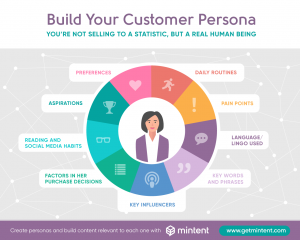
Finally, you create those segments so you can better craft marketing campaigns and tactics that better resonate with particular groups. Obviously, if you’d run the same marketing campaign to all of your prospects, it wouldn’t perform as well across all groups, because the people are different. This is why you develop segments so you can craft marketing campaigns that are personalized for each segment. The more specific you get with your market segmentation, the more aligned your messaging will be with your target audience, and thus, you’ll be able to drive more conversions.
Now, before you present any objection to using market segmentation, let me say that it can be used by all businesses of all sizes and in all industries.
That’s because personalized customer experiences work. Humans buy from brands they trust and have a relationship, and when the marketing resonates with them, it makes it seem like you’ve known each other forever.
Market segmentation is used by giant corporates like Coca-Cola, all the way down to the smallest startups.
Why you should use market segmentation
The benefits of market segmentation are many. It is the foundation for a successful marketing campaign.
If your market segmentation and targeting fail, it will significantly harm your results.
Market segmentation is crucial for businesses, allowing them to tailor their sales and marketing efforts. When you divide a large market into small groups, creating more personalized messaging is easier to improve customer satisfaction and boost sales and overall business revenue. Furthermore, you can combine market segmentation and advanced website personalization to deliver excellent customer experiences.
Target marketing and market positioning are critical in market segmentation. Target marketing involves determining a specific consumer group a business wants to serve. On the other hand, market positioning outlines the benefits of a product, making it better than its competitors for higher business success.
Market segmentation leads to higher ROI
As you can expect, when the messaging of your marketing resonates better with your target audience, more people will be impacted by it, and ultimately more convinced to buy. As a result, a more tailored and relevant marketing campaign that is created with the audience in mind will generate a lot higher ROI than those that don’t.
This is a reason why television ads are losing efficiency and traction as it has to compete with other marketing sources that allow you to laser target your segment when marketing. When you advertise on a television, you market to the large mass. You have no idea of who saw your ad either.
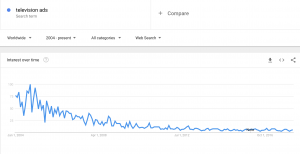
And so, you have to create a very generic ad that is meant to resonate with everyone, but what instead ends up happening is that it resonates very bad with everyone, as the key to great marketing results is being specific.
And this is what market segmentation allows you to be.
Market segmentation lead to better relationships and brand recall
The key to getting someone to buy from you is making them trust you, and resonate with you.
When you incorporate market segmentation, you market with them in a much more personal way that is tailored for their specific segment, and what happens is that they feel like you’ve known each other forever, and even better, they resonate with your marketing campaign.
A clever way to do this is to understand why your customers use your products and how you use them.
For instance, if you know that a group of customers use your scarves as socks, creating a marketing video where someone uses your scarves as socks will make these individuals see themselves in the video, resonate better with your brand, and have you on top of mind as a result of you impacting them on a personal level.
And doing so isn’t possible without segmentation.
Better use of resources
When working with market segmentation, you’ll be able to better locate your resources, because you’ll be able to identify which segments you should prioritize, and which groups drive the highest engagement and revenue for your brand. So instead of spreading your budget across the whole market and only having a certain segment catch on, you can instead double down on the segment that resonates with you and drives a better result.
A greater understanding of the target audience
Your customer segmentation allows you to identify the customers, the segment that is resonating best with you.
And what this allows you to do is get a better understanding of who those individuals are and what they are all about.
And once you’ve mastered that segment, you can hop on to the next one, yet one that is very closely related to the segment you’re already focusing on.
By doing this, you can slowly but surely expand your segments, yet still do it in a way which gets you in contact with individuals who actually care about your brand and industry.
How to develop segments for your customers and targeting
Of course, the first step you need to do is divide the market of potential customers into segments based on characteristics and traits that are shared among individuals in one segment.
Doing this first demands you to define the differences between your different prospects, and then segmenting them. The segments are often divided into two parts: basic segmentation, and advanced segmentation.
When talking about market segmentation, these are often the categories that are focused on:
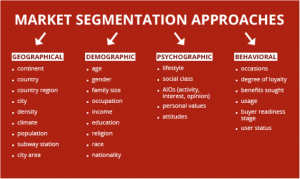
In other words, four categories which in turn are divided into many other sub-categories.
Gender
Gender is the most basic criteria of customer segmentation. While gender won’t be of importance for certain marketers, it has the greatest importance for others. Because generally speaking, many needs differ between men and women. So if your business is highly dependent on customers because they are of a particular gender, this criteria is one that is worth paying attention to.
Job
The occupation of your target audience will influence your prospects, most importantly in terms of their decisions. For instance, a person working with the stock market might have completely different needs than a person working as a plumber. Therefore, understanding the occupation of your prospects is important for understanding their needs.
Lifestyle
The lifestyle of your customers has a great effect on them and their needs. The lifestyle individuals have can influence their needs and also their wants. The lifestyle is quite a broad criteria which includes things like interests, marital status, hobbies, religion, values, and much more.
Age group
Age is a highly relevant criteria for segmentation in your marketing. In marketing, age normally has a huge importance to customers, and so, if you’re creating an advertisement dedicated to teens and then showing it to 40-year olds, your ad won’t resonate with them.
Income
Income is of the greatest importance in marketing. Obviously, if you’re selling Lamborghinis, you shouldn’t target people with a low or average income, because these won’t be the individuals who buy from you. Accordingly, you should craft your targeting based on the high-income individuals, because these are the ones that will buy from you.
Moreover, low-income individuals have different wants and needs compared to high-income individuals, and this is why it’s important to know to which audience, which segment, you’re catering to as a brand.
The income groups are often segmented into three categories:
- High Income Group
- Mid-Income Group
- Low Income Group
Identify which of these groups you target to better reach and resonate with your ideal customers.
Place
Place is an important segment to have in mind. This is the place where you are operating, and the place where your customers can reach you.
If you’re a brand operating solely in a physical location, then obviously, your location is the most important thing. If you have an online shop, then it’s not as important, but still not insignificant.
”Advanced and specific” market segmentation
Now, the basic segmentations are helpful in creating different segments for your target audience, however, if you want a more in-depth insight into your target audience, you want to dig a little bit deeper into the more advanced criteria.
Geographic Segmentation
The place not only affects how and if people can reach your brand, but it also affects people’s needs and wants. For instance, people living in the Sahara desert will probably have a greater need for water compared to people living in the Alps.
As a brand, you need to understand that people from different geographic areas have different needs, and so, you need to approach them differently.
It is also important that you know that your products might be used for different things in different areas.
For instance, if you’re selling scarves, one group of people from one geographical area might use it as a scarf, another group might use it as a bandana, and another group might use it as a belt.
The better insight into how different audiences in different areas are using your products, the better you can target them in your marketing.
Behavioral Segmentation
Behavioral segmentation is focused on a customer’s relationship with your brand and products.
The reason is that their relationship with your product will have a great impact on their buying decision.
For instance, a person who has never heard about your product or brand has a longer journey until they buy from you, compared to someone who has already bought from you and is super satisfied, right?
- The customers can be divided into the following categories based on their relationship with your brand:
- People who are unfamiliar with your brand
- People who have heard about your brand
- People who have heard about your product
- People who are loyal existing customers
- People who have bought from you one or two times
- People who are likely to buy from you
Demographic Segmentation in marketing
In marketing, the demographic segmentation is the most common category. It includes basic things like all of the things listed in the basic segmentation (and more) and together creates a segment. This includes things like age, gender, marital status, job, and much more.
The major benefit of all of this is that you understand your customers better. And when you understand your customers better, you’ll soon understand that not all customer have the same needs, as some marketers tend to believe. Accordingly, you’ll be able to craft marketing messages for specific groups of your audience that will resonate point on with them.
For example, you might have watched the television, and then an advertisement came up that felt like it read your mind. So you resonate with it, and maybe even buy the product. This is marketing segmentation at its finest. The goal is to make your target audience resonate with your marketing so well that they don’t want to buy anything else and ignore your competitors. And in order to do so, you need to work with market segmentation.
How to leverage market segmentation to improve your conversions
Okay, so now that you know what market segmentation is, and how you can categorize your customers into different segments, you are probably very eager to start implementing it into your marketing strategy so ultimately, you can drive more sales.
But before we begin, it’s important that you have been able to define your different segments. Because after all, running segmented marketing is dependent on knowing your audience and the segments that they fit in.
For instance, one of your audience segments might be teenage boys living in New York, and if you want to focus on targeting them, you should tailor your marketing campaigns accordingly.
When you know your different segments, it’s time to dig into the more practical parts.
Can you reach your audience? – if so, how?
This is the most crucial question you need to ask yourself once you’ve identified a segment.
The reason you do marketing in the first place is to reach your target audience and make them aware of your brand’s existence, but if you aren’t able to reach your audience, it won’t matter if you’ve created a marketing segmentation or not.
Try to identify where your audience spends time and where you can reach them.
This is a reason why different brands use different social media platforms and have different strategies for using them.
Because different audiences are using different social media platforms, and if you plan on using social media for your marketing campaign, it is good to know the demographics of the platform you plan on using so that you select a platform on which you can actually reach your segment.
Understand your segment’s unique needs
As a brand, identifying the unique needs of your segment is everything.
Because as a brand, what you’re going to do is help them solve their problems, and thus help them with their needs, but if you have no idea what your segment’s needs are, you won’t be able to speak to them, because you don’t have a value proposition.
You probably know by now that different segments have different needs, and so, before you set out to target a specific segment in your marketing, it is important that you know their specific needs.
For instance, a struggle for Coca-Cola has always been to get people who are very aware of their health to buy their drinks, and so, they created Coca-Cola Zero and Coca-Cola Light. and then also Coca-Cola Life. Their new products solved an issue and need for the people who wanted to enjoy the great taste of Coke but without having to worry about their health, or breaking their diet. Now, whether or not they are healthier is debatable, but at least they are developed to come off as “healthy”. This allows Coca-Cola to build a larger audience by creating products that spoke to a new segment of people. All of this thanks to segmentation, and understanding the different needs of their audience.
Market segmentation for personalized experiences
In marketing, personalization is everything.
Maybe you’ve shopped at a place and received something with your name on, or maybe you’ve come to a hotel to find a hand-written written just for you.
The feeling of personalization is wonderful, and it makes us appreciate and resonate with a brand tremendously, thus making us much more loyal.
Segmenting for personalized customer experiences means tailoring customer’s customer experience based on their individual needs. I read a story once about someone who stayed at a hotel and had a box of chocolates waiting for him. He only liked white cocolate, so he ate the two that were there and went out for a meeting. In the evening, he came back to his room to find that two new white chocolates were added to the box.
So in the morning before he left, he ate the two white chocolates, and when he returned, he found that the whole box of chocolates was filled with white cocolates.
This is the epitome of paying attention to details and personalizing a customer experience, and doing that little extra that will make the customer remember for you for the rest of their lives.
Really, the foundation to using market segmentation is providing your customers with personalised experiences, all based on their needs and their preferences. This is why the word personalisation needs to constantly be in mind when working with segmentation.
Leverage your customer’s geolocation
Geolocation is a simple yet effective way to create a more personalized expeirence for your customers, and to make them relate with you better.
Neil Patel used this strategy by using a geolocation tool which identified where the visitors where from, and then writing their location as seen below.
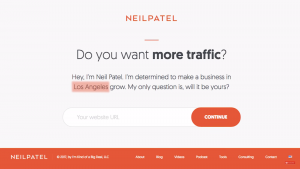
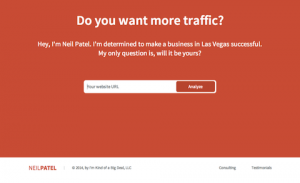
By doing something as simple as that, people will think ”I am a business in Las Vegas, I want to grow my business”, and so the people visiting will feel like the message is created specifically for them.
There are a number of other ways you can use geolocation to make for a more personalized experience.
For instance, you can showcase relevant information about their particular city on your website, show the local weather, or ”common asked questions from people close to you”.
Segmentation in ad targeting
While advertising opportunities like tv and radio ads give very little opportunity to target your audience, advertising on the internet, such as Facebook ads, Instagram ads, and Google ads give you rich opportunities to target the people who matter to your business.
But when doing so, you shouldn’t just use the targeting criteria which defines all of your brand’s customers.
Because as we’ve talked about, the ad you have crafted probably doesn’t speak too well with all of your potential customers.
Instead, you need to make sure that the message and ad you’re presenting resonates with the target audience you’re going after.
For instance, if one segment of your audience is single mothers at the age of 40-45 who all have a passion for fitness, then you need to craft a message that speaks to them, as well as use targeting that targets them and them only.
Then, you can crate another ad campaign targeting men at the age of 40-45 who are married and live in France, for example. You should then tweak your message to suit that segmented audience.
This is what it’s all about – tailoring the message to suit each segment, and understanding that all of the people in your target uadinece are the same and resonate with the same things, because that is far from the truth.
Personalised emails with segmentation
Back in the days, those that were leveraging email marketing had a close to 100% open rate.
The reason?
People treated emails like mail, carefully opening and reading each and every message.
But as more and more brands incorporated email marketing into their marketing strategy, to the point today where almost all brands are using email marketing, you can expect the open rate has dramatically, to the point where the open rate of marketing emails are just a few percent.
But the good news is that with market segmentation, you can increase your open rate, and boost your conversions as a result.
In fact, Personalized email messages improve click-through rates by an average of 14% and conversions by 10%.
And what’s more, Emails with personalized subject lines are 26% more likely to be opened.
Lastly, and this is probably most impressive: Marketers have noted a 760% increase in revenue from segmented campaigns.
All of these statistics are mind-blowing, but they’re not surprising.
But from those statistics, we can take several things with us.
First off, a ”newsletter email” or marketing email is most likely not suited for your whole email list, whether it contains 100, 4,000, or 100,000 subscribers. Those individuals can probably in turn be divided into different segments based on things the different individuals have in common.
This means that the best way to generate results with your marketing email isn’t to make an email and then bash it out to your complete list. But instead, it is to segment your email subscribers, and then create a number of personalised emails that are personalised and tailored for that exact group of people.
Sure, it will take a bit longer time, but as the statistics proved, it will be worth it.
And remember, when your emails are more relevant to each individual, your unsubscribe rate will decrease significantly.
You can segment your audience based on a number of different factors, as presented in the beginning of this article. And a common way to segment in email is by segmenting based on the different stages they are at in your conversion funnel.
A very simple way to increase your open rate and in turn conversion rate is by personalising the subject of your email.
Some brands do it by adding your name in the description on the email, which then targets the individual rather than a group. And another way is to write something in the subject line that speaks to the customer in that particular segment.
For instance, if I am in the consideration stage of the sales funnel, then an email saying ”are you still contemplating whether or not you should buy?” will speak to me, and increase the chances of me opening the email. And if the email said ”if you are still thinking about buying, here’s an extra 10% off”, It would further speak to me based on the part of the funnel I was.
Topshop is a brand that has realized this:
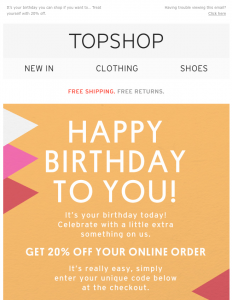
In that way, knowing what parts of the sale funnel your customer is allows you to better tailor your message and speak to your audience.
Shopping personality
As mentioned, knowing what part of your sales funnel your customers are can be tremendously effective in getting them to convert, but another way of increasing sales based on market segmentation is knowing what type of shoppers they are.
For instance, if a customer segment of yours is people who spend a lot, you can have different rewards at different stages to encourage them to buy more.
For instance, if you purchase for $500, you get $20 back, if you buy for $600, you get $40 back, and so on. This will speak to the people in the segment who are big spenders, and encourage them to buy more from you.
Here’s one from JCPenney:
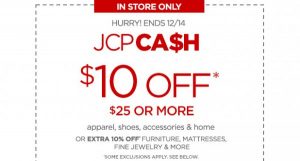
Knowing for example the people who have abandoned their carts is simple. You can quickly identify them, and reach out to them. These individuals are in the same segment, and what you need to do is encourage that segment to check out and buy from you. There are plenty of tricks on how you can decrease your abandoned cart rate, but the foundation for doing so is obviously knowing why they left. If they just forgot about it, maybe you just need to remind them, but if they need to be convinced, then maybe offering a special personalised discount or free shipping is what it takes.
Segmenting old and new customers
You’ve probably come across brands who segment old and new customers yourself, and separating these are highly important for increasing conversions.
If you’ve purchased something from a website, and then returned, maybe you’ve gotten a ”welcome back message”. This is a form of personalisation based on you being in the segment ”old customer”.
There are really an endless amount of opportunities when it comes to segmenting customers based on their previous connection with your brand, and one of them is retargeting, which I’ll go into more in detail in the next point.
A way to welcome new visitors to your website is by guiding them around, for instance offering video tutorials, instructions, and maybe even an informative post.
If you want to speak to existing customers, you can always provide them with things they found interesting earlier, for instance if they have bought a particular kind of trousers, or if they’ve looked at a particular kind of model etc.
Retargeting
Retargeting is a powerful thing, and something within market segmentation that has proven to be extremely effective.
And that’s why a large portion of brands are allocating money for it.
Retargeting means advertising to people who have previously been in contact with your business, for instance visited your website or signed up to your newsletter.
Maybe you’ve looked at a pair of shoes or a computer and then found a giant ad in your face of that exact computer and those exact shoes in your face.
What brands often do is run retargeting ads to people who for some reason didn’t convert, whether it be that they just looked at a product, or abandoned their shopping cart, and then they show that they have lowered the price, or that they offer free shipping etc.
In other words, anything that will help them get the customer to take the step to purchase.
And the reason retargeting works so well is firstly because that person has shown an interest in the brand, whether it be by adding products to the shopping cart or looking at a product. This means that the customer is, in theory more relevant than other people who have never shown any interest in the brand. Secondly, retargeting is done by leveraging the information that could be extracted from that particular customer’s actions, making the ad much more personalized and specific for that particular indivudidual.
If I look at a pair of shoes and then see those shoes in an ad 10 seconds later, chances are, that ad will be quite relevant to me, right?
Conclusion
Segmentation inmarketing is tremendously effective as it ensures you’re only reaching the people who truly matters, and that you reach them with the right message. Far too many brands are aiming too broadly, which results in more expensive marketing, and less effective marketing.
By better targeting your marketing efforts, you’ll be able to generate better marketing results.
Simple!


